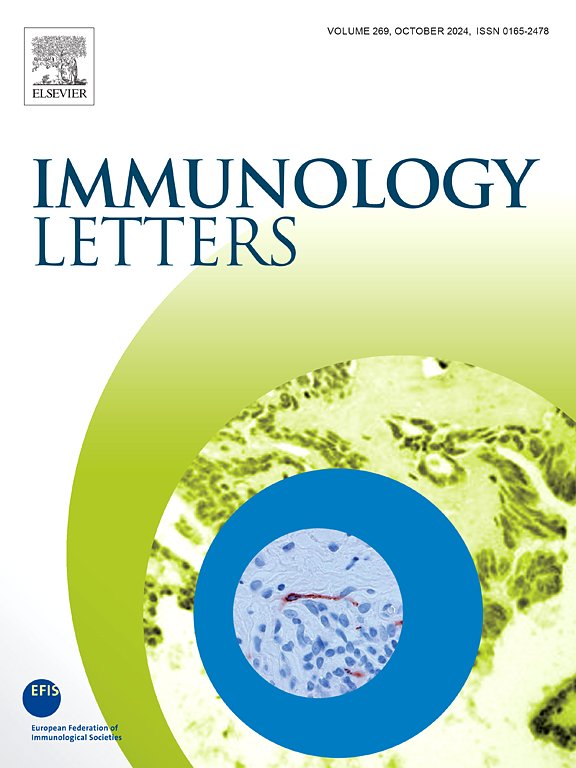Low IL-35 expression in CSF is associated with Neuro-Behcet Disease: Comparative analysis between parenchymal and Non-parenchymal NBD
IF 2.8
4区 医学
Q3 IMMUNOLOGY
引用次数: 0
Abstract
Background
IL-35 is a recently discovered immunoregulatory cytokine that inhibits inflammatory cytokines by suppressing their lineage-specific transcription factors. The objective of this study was to investigate the expression of IL-35 in the cerebrospinal fluid (CSF) of patients with Neuro-Behçet Disease (NBD). An immuno-comparative analysis was performed between parenchymal NBD (pNBD) and non-parenchymal NBD (npNBD).
Methods
We are investigating CSF IL-35 levels in 45 patients with (NBD), comprising 25 patients with pNBD and 20 with npNBD, compared to 27 patients with multiple sclerosis (MS) and 20 patients with non-inflammatory neurological diseases (NIND). We assessed the inflammatory cytokines (IL-1α, IL-18, IL-33, IL-36), Foxp3 and CD4+ CD25+ Foxp3+ regulatory Treg T cells (Tregs). The following methodologies were employed: flow cytometry, ELISA, and real-time polymerase chain reaction (RT-PCR). For RT-PCR analysis, we calculated relative gene expression in target genes using the comparative CT method with the equation 2−ΔΔCt. We employed a receiver operating characteristic (ROC) curve to investigate the predictive value of IL-35 levels.
Results
Protein and relative mRNA expression of IL-35 were significantly decreased in NBD and MS patients compared to the NIND group. Significantly lower CSF IL-35 mRNA (p = 0.0001) and protein (p = 0.0004) were observed in patients with pNBD compared to npNBD. The study revealed that NBD patients exhibited low Treg counts, and a significant positive correlation was identified between Treg numbers and CSF IL-35 (r = 0.554, p = 0.0001). Negative associations were observed between Tregs and CRP (r =- 0.518; p = 0.0001) and ESR (r = -0.571; p = 0.0001) in NBD. Levels of the pro-inflammatory mediators were found to be elevated in contrast to a low Foxp3 level in NBD, which was more reduced in pNBD compared to npNBD. In vitro cultured memory T cells from pNBD patients stimulated with LPS showed high levels of IL-1α, IL-18, IL-33, IL-36 and low levels of Foxp3 and IL-35 measured in the culture medium. After the addition of recombinant human IL-35 (rhIL-35), Foxp3 and IL-35 were significantly increased and inflammatory cytokine levels were reduced. These results suggest that rhIL-35 may induce a regulatory effect on Foxp3 and IL-35.
Conclusion
These findings imply a critical reduction of IL-35 in pNBD patients. The combined protein and gene expression of the tested inflammatory cytokines suggest that there are distinct inflammatory mechanisms governing the central nervous system in pNBD. Further work is essential for the development of targeted interventions for the effective treatment of patients.
脑脊液IL-35低表达与神经白塞病相关:实质性与非实质性NBD的比较分析
背景:IL-35是最近发现的一种免疫调节细胞因子,通过抑制其谱系特异性转录因子来抑制炎症细胞因子。本研究的目的是探讨IL-35在神经behalet病(NBD)患者脑脊液(CSF)中的表达。对实质性NBD (pNBD)和非实质性NBD (npNBD)进行免疫比较分析。方法:我们正在研究45例NBD患者的CSF IL-35水平,包括25例pNBD患者和20例npNBD患者,与27例多发性硬化症(MS)患者和20例非炎症性神经系统疾病(NIND)患者进行比较。我们评估了炎症因子(IL-1α, IL-18, IL-33, IL-36), Foxp3和CD4+ CD25+ Foxp3+调节性Treg T细胞(Tregs)。采用以下方法:流式细胞术,ELISA和实时聚合酶链反应(RT-PCR)。对于RT-PCR分析,我们使用比较CT法计算目标基因的相对基因表达量,公式2-ΔΔCt。我们采用受试者工作特征(ROC)曲线探讨IL-35水平的预测价值。结果:与NIND组相比,NBD和MS患者IL-35蛋白及相对mRNA表达均显著降低。与npNBD患者相比,pNBD患者CSF IL-35 mRNA (p = 0.0001)和蛋白(p = 0.0004)显著降低。研究显示,NBD患者Treg计数低,Treg计数与CSF IL-35呈显著正相关(r = 0.554,p = 0.0001)。Tregs与CRP呈负相关(r =- 0.518;p = 0.0001)和ESR (r = -0.571;p = 0.0001)。在NBD中,促炎介质水平升高,而Foxp3水平较低,与npNBD相比,pNBD中Foxp3水平更低。LPS刺激pNBD患者体外培养的记忆T细胞,培养液中IL-1α、IL-18、IL-33、IL-36表达水平较高,Foxp3、IL-35表达水平较低。加入重组人IL-35 (rhIL-35)后,Foxp3和IL-35水平显著升高,炎性细胞因子水平显著降低。这些结果表明rhIL-35可能诱导Foxp3和IL-35的调控作用。结论:这些发现提示pNBD患者IL-35的显著降低。所测试的炎症细胞因子的蛋白和基因联合表达表明,pNBD中存在不同的炎症机制控制中枢神经系统。进一步的工作对于制定有针对性的干预措施以有效治疗患者至关重要。
本文章由计算机程序翻译,如有差异,请以英文原文为准。
求助全文
约1分钟内获得全文
求助全文
来源期刊

Immunology letters
医学-免疫学
CiteScore
7.60
自引率
0.00%
发文量
86
审稿时长
44 days
期刊介绍:
Immunology Letters provides a vehicle for the speedy publication of experimental papers, (mini)Reviews and Letters to the Editor addressing all aspects of molecular and cellular immunology. The essential criteria for publication will be clarity, experimental soundness and novelty. Results contradictory to current accepted thinking or ideas divergent from actual dogmas will be considered for publication provided that they are based on solid experimental findings.
Preference will be given to papers of immediate importance to other investigators, either by their experimental data, new ideas or new methodology. Scientific correspondence to the Editor-in-Chief related to the published papers may also be accepted provided that they are short and scientifically relevant to the papers mentioned, in order to provide a continuing forum for discussion.
 求助内容:
求助内容: 应助结果提醒方式:
应助结果提醒方式:


